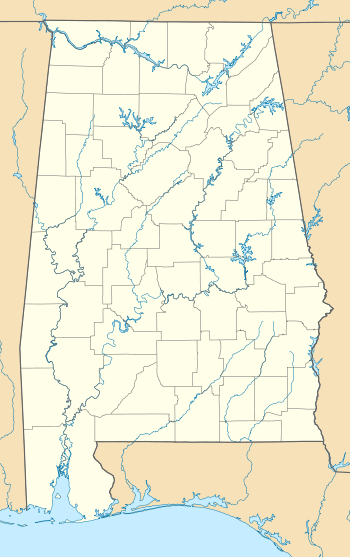Glenville, Alabama
Glenville (also spelled Glennville) is an unincorporated community in Russell County, Alabama, United States. Formerly it was in Barbour County. During the Civil War, Company "H" of the 15th Regiment Alabama Infantry was raised from Barbour and Dale Counties and called the "Glenville Guards".[3] The Glennville Historic District, containing the antebellum core of the community, is a historic district listed on the National Register of Historic Places in 1979.[2]
History
Glennville was the first permanent community in what is today Russell County. It was founded in 1835, after the Muscogee removal, by Methodist preacher James Elizabeth Glenn. The town quickly developed into an economic and cultural center of East Alabama. In addition to the Methodist Church, the community was home to Male and Female Academies and the Weyman
School for Girls, all of which were renowned throughout the South for their classical curricula. The town also had a post office, stores, a Masonic Lodge, and an inn. The town incorporated in 1854, seeking to attract a rail line, but the line was opposed by many planters in the community. With railroad bypassing Glennville and diminished power and influence of farmers after the Civil War, the town gradually faded.[4]
Architecture
The historic district consists of 32 main structures, 27 outbuildings, and 6 cemeteries. The most prominent are antebellum plantation houses, most of which exhibit Greek Revival style. The Methodist church (built circa 1850) is also Greek Revival, while the Episcopal church (1926) shows Gothic influence. Late 19th- and early 20th-century tenant farmer houses are more modest, and reflect the changing fortunes of the town.[4]
Notable resident
References
- ↑ "Glenville". Geographic Names Information System. United States Geological Survey.
- ↑ 2.0 2.1 "National Register Information System". National Register of Historic Places. National Park Service. July 9, 2010. Retrieved March 25, 2015.
- ↑ Parker, Matt. "15th Alabama Infantry Regiment". Thomas Legion. Retrieved March 26, 2015.
- ↑ 4.0 4.1 Moore, Sally (May 22, 1979). "Glennville Historic District". National Register of Historic Places Inventory-Nomination Form. National Park Service. Archived from the original on March 25, 2015. Retrieved March 25, 2015. See also: "Accompanying photos". Archived from the original on March 25, 2015. Retrieved March 25, 2015.
Greater Columbus, Georgia |
|---|
| | Central cities/Largest cities | |  Location of the Columbus, Georgia-Auburn, Alabama CSA and its counties:
Columbus, Georgia Metropolitan Statistical Area
Auburn, Alabama Metropolitan Statistical Area
Tuskegee, Alabama Micropolitan Statistical Area (defunct) |
|---|
| | Cities in Georgia | |
|---|
| | Cities in Alabama | |
|---|
| | Counties in Georgia | |
|---|
| | Counties in Alabama | |
|---|
|
|
|---|
| | Lists by county | | |
|---|
| | Lists by city | |
|---|
| | Other lists | |
|---|
| |
|




